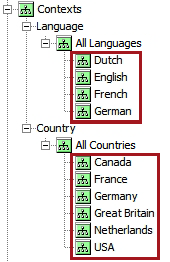This documentation section explains dimensions and dimension points, which are maintained in the STEP Workbench under System Setup > Contexts.
Dimensions
A dimension is a definition of a context-sensitive domain in STEP, such as language or country, which allows for different layers of information in which content can vary. A dimension is presented in STEP as a hierarchy of dimension points. Each system must have at least one dimension.
Common examples of dimensions are 'Language' and 'Country,' as shown in the below screenshot.

Dimension Points
Contained within dimensions are dimension points. A dimension point is, for example, a specific language or country. Data is stored in STEP in dimension points.

Dimensions are general and dimension points are specific.
Note: Though 'All Languages' and 'All Countries' are also dimension points, they should never be used when creating a context. Refer to the Dimension and Dimension Points Recommended Practices topic (here) for more information.
Dimension Dependent Data
Data is stored in STEP in dimension points. In order to place data into different dimensions, the object type, attribute, and/or reference type that will either contain or link the data together must be made dimension dependent.
Note: Data is not stored in contexts.
- Object types are made dimension dependent if they should have different STEP names in different contexts. In most cases, this is because the names are translated into different languages, though they may also have different names in different markets, for example.
For information on making object types dimension dependent, refer to the Maintaining Dimension Dependent Object Types topic here.
- Attributes are made dimension dependent when their values should be different in different contexts. This also includes lists of values (LOVs).
For information on making attributes dimension dependent, refer to the Dimension Dependent Attributes topic in the Getting Started documentation here.
- Reference types are made dimension dependent when different linked objects (typically assets) should be visible in different contexts.
For information on making reference types dimension dependent, refer to the Dimension Dependent Reference and Link Types topic here.
- Assets can be made dimension dependent but this is a global setting applied under System Setup > Users & Groups > Image & Document Settings. For more information, refer to the Image and Document Settings topic here.
Note: In almost all circumstances, assets can be 'swapped out' in different dimensions by use of dimension-dependent reference types.